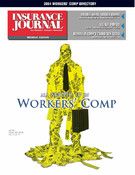Recently, while conducting an education program for a group of agency professionals on the subject of workers’ compensation, I realized that for many agents, the workers’ compensation policy is the redheaded stepchild of insurance policies. It has the reputation of not requiring or deserving a lot of attention, yet my agency background supports quite the opposite position.
You can make a world of difference to clients through this policy, which can ultimately spell dividends in opening the door to other lines of coverage — if you are willing to take the time to fully analyze your customer’s work comp exposures and select the appropriate insurance partner for this very special coverage.
Once financial stability has been determined, there are four areas that I suggest you examine when it comes to selecting a carrier you and your customer can trust: (1) underwriting, (2) claims, (3) loss control and (4) technology.
Underwriting
Too many agents today are willing to simply copy the existing workers’ compensation policy and fill in the blanks on the application without discussing exposures with the prospect. Failing to thoroughly review an account at the outset leaves the door open for your competitors to take the account away from you if they are able to identify errors you have made. Classification errors, ignored payroll limitations resulting in overcharges and incorrect experience modifiers not only cost you credibility with the workers’ compensation policy, but with other lines as well.
This is where your carrier can make a difference. Select one whose underwriters or staff are willing to help you navigate the workers’ compensation policy through supplemental information or training programs on auditing procedures, promulgation of experience modifiers and governing class codes. Also look for a carrier whose underwriters are willing to take the time to discuss classifications and examine experience modification worksheets. Finding and fixing mistakes on the policy means returning money to the client, which adds value to your relationship.
Claims
Claim costs normally escalate because the employer doesn’t know what to do when an injury occurs and doesn’t know how to manage the claim afterwards. Assist your insured in advance by providing them with up-front instructions in the event of an injury or illness. Take the time to review the First Report of Injury and even consider providing them with a copy of your state’s employer rights and responsibilities and injured worker rights and responsibilities documents. These few steps will go a long way in building your relationship with your client and with your carrier.
Obviously, your carrier should be committed to cost containment. Verify for yourself that the carrier employs claims professionals fully trained and experienced in the state’s regulations and guidelines for benefits. The carrier’s team of professionals should be focused on taking care of the injured worker while enlisting every opportunity available to keep costs to a minimum. They should also be prepared to share their success with you.
Loss control
The most critical question for your insured is: Where are our losses coming from? Again, your selected carrier should employ a committed group of loss control professionals who can assist your clients via on-site evaluations and training to ensure that the employees operate in a safe manner and work in a safe environment.
Consider whether the company’s loss control professionals are available to answer questions relating to OSHA compliance, to offer assistance in the area of job descriptions that ensure inclusion of essential job elements for the purpose of developing return-to-work programs, and to provide sample drug and alcohol programs. More importantly, consider whether you understand what your carrier has to offer your customer and yourself.
Technology
The final consideration in selecting a carrier is commitment to technology. In addition to offering online quoting capabilities, is the carrier offering loss information or claims status capability via an interactive Web site? Is the organization offering itself as a resource for information — both from a technology standpoint and a technical standpoint? Are you aligning yourself with a carrier that is committed to assisting you in the management of your business by offering training that will help you maximize these services?
Workers’ compensation coverage is an untapped gold mine for many agencies. By operating at the highest level of professionalism and aligning yourself with the best carrier for the coverage, you can enhance the financial position of your client and protect your reputation and credibility at the same time.
Janett Kearbey is the director of workers’ compensation education and production for Service Lloyds Insurance Co.
Was this article valuable?
Here are more articles you may enjoy.


 FBI Involved After Two Florida Injury Lawyers Go Missing From Fishing Trip
FBI Involved After Two Florida Injury Lawyers Go Missing From Fishing Trip  ’60 Minutes’ Homeowners Ask Court to Force DFS to Divulge Heritage Probe Info
’60 Minutes’ Homeowners Ask Court to Force DFS to Divulge Heritage Probe Info  Berkshire Hathaway Raises New CEO Abel’s Salary to $25 Million
Berkshire Hathaway Raises New CEO Abel’s Salary to $25 Million  High-Net-Worth Risk Appetite Drops as Some Regions Show Stabilization
High-Net-Worth Risk Appetite Drops as Some Regions Show Stabilization 


